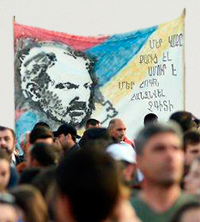
Religious thinking in the West has undergone great transformations since the 1960s. One can recall the Second Vatican Conference, which opened a new phase for the Catholic Church. An equivalent event in Eastern Europe was the overthrow of communist atheist regimes, which allowed churches to emerge from the shadows and engage in fervent activity.
No less important was the rapid development of mass culture, the media, which changed the human emotional world. As a result of these new developments, quasi-religions developed rapidly. “Quasi” means “like”, “quasi-religion” – a religious feeling, which at first glance resembles a religious feeling, is almost religious, but it is only an external impression.
True religion, whether traditional or not, is based on the only absolute truth, the “message of God.” There is no such certitude in quasi religions.
For a Christian, religion is communication with God, but theologians often use the term “Ultimate Reality” to refer to religious experience as “communication.”
Based on similar notions of religion, the American theologian Joachim Wach (Wach J., 1898-1955) introduced the concept of “false religion.” According to him, “false religion may have the structure of a true religion, but through that religion man relates not to a limited but to a finite reality.”
He chose Stalinism as the first example, with its cults and rituals. The second example is the cult of life and sexuality, which is often typical of liberals. The third type of false religion is the worship of a nation or race, such as Nazism in Germany or the ethno-religion of Nzhdeh in Armenia. And the fourth example he gives is the worship of the state, which is often called civil religion. It is specific to American society, Japan, South Korea. Such examples can be continued.
These examples show that any ideology can be transformed into a false religion when the cult-ritual elements are strengthened in it. False religions are one of the expressions of the secularization mutations of our time, when the “secular” begins to imitate religious practice.
The ideas of J. Wach were further developed by the American theologian and culturologist Paul Tillich (Tillich P., 1886-1965).
P. Tillich positively evaluates secularism and modernity, because they demagogicized religion through rational approaches. Pre-modern Christianity was ecstatic, based on magical ideas. Secularism purified faith from such approaches.
Quasi-religions, like real religions, offer mankind their own version of the meaning of life, offer answers to existential questions, though for them science, nation, progress are bordering one another, except for the sacred.
With this approach, the process of turning socialism into a quasi-religion becomes clear. Stalinism enchanted the ideas of Marxism, and the Soviet state became a pseudo-caliphate, waging a jihad, a holy war against the enemies of the people – capitalism.
Paul Tillich criticizes humanism, which is the limit of man, it can be turned into a quasi-chronicle. P. Tillich sees a certain resemblance between the Spirit of the Protestant religion and that of humanism. They both risk losing their identities in the fight against more powerful quasi-religions. That is why he sees the future of Christianity in the alliance of these two formations.
Quasi religious properties can be detected in a variety of organizations, including environmental movements, alien researchers, various humanitarian organizations, and more. Researchers especially emphasize the tendency of American society to create quasi-religious organizations.
The latest such example is the events surrounding the assassination of George Floyd by police officers. After that assassination, there was a strong protest movement not only in the United States but also abroad. The main organizer of the protest movement in the United States is the Black Lives Matter organization. The protest movement is supported by many influential religious figures. Mass religious ceremonies were held at the scene of Floyd’s assassination, and miracles are even reported. George Floyd, a victim of political violence, becomes a martyr of religious significance, an object of new worship.
Such phenomena can also occur in Armenia. Particularly during the change of power in 2018, such manifestations were expressed. In general, revolutionary spirit bears some resemblance to religious ecstasy, which is more vocal among the general public. In 2018, about a dozen songs were dedicated to the revolution, where Nikol Pashinyan is called the savior. The masses introduced new ceremonies and mass shouts. In general, when the masses wake up from a passive state, they turn into mass movements, objects of worship, symbols and symbolic songs, orators-preachers appear.
It is noteworthy that many cases of “revolution” on social networks, joined by many revolutionaries, already in high positions, claimed that “the Prime Minister is unconditionally supported, he is, in fact, beyond criticism, and whoever criticizes, is a counter-revolutionary.” Any religion is based on accepting the words of its prophet without criticism, because the “savior” can not be criticized, at best he can be interpreted.
The pathos of the revolution is declining in Armenia, which is natural, idols fail over time, but that is not the problem, the problem is the tendency of a significant part of the society towards the quasi-religion. The holy place is never empty, let’s wait for the appearance of new saviors and new quas-religions in Armenia.